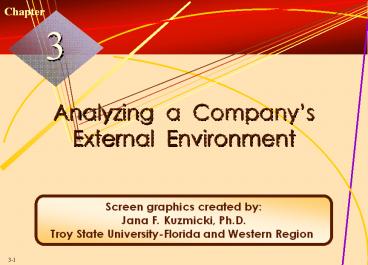Crafting and Executing Strategy 14e PowerPoint PPT Presentation
Title: Crafting and Executing Strategy 14e
1
Chapter
Analyzing a Companys External Environment
Screen graphics created by Jana F. Kuzmicki,
Ph.D. Troy State University-Florida and Western
Region
2
Chapter Roadmap
- The Strategically Relevant Components of a
Companys External Environment - Thinking Strategically About a Companys Industry
and Competitive Environment - Question 1 What Are the Industrys Dominant
Economic Features? - Question 2 What Kinds of Competitive Forces Are
Industry Members Facing? - Question 3 What Factors Are Driving Industry
Change and What Impacts Will They Have? - Question 4 What Market Positions Do Rivals
OccupyWho Is Strongly Positioned and Who Is Not? - Question 5 What Strategic Moves Are Rivals
Likely to Make Next? - Question 6 What Are the Key Factors for Future
Competitive Success? - Question 7 Does the Outlook for the Industry
Present an Attractive Opportunity?
3
What Is Situation Analysis?
- Two considerations
- Companys external ormacro-environment
- Industry and competitive conditions
- Companys internal ormicro-environment
- Competencies, capabilities,resource strengths
and weaknesses,and competitiveness
4
Fig. 3.1 From Thinking Strategically about
the Companys Situation to Choosing a
Strategy
5
Fig. 3.2 The Components of a Companys
Macro-Environment
6
Key Questions Regarding theIndustry and
Competitive Environment
7
Q 1 What are the Industrys Dominant
Economic Traits?
- Market size and growth rate
- Scope of competitive rivalry
- Number of rivals
- Buyer needs and requirements
- Production capacity
- Pace of technological change
- Vertical integration
- Product innovation
- Degree of product differentiation
- Economies of scale
- Learning and experience curve effects
8
Q 2 What Kinds of Competitive Forces Are
Industry Members Facing?
- Objectives are to identify
- Main sources of competitive forces
- Strength of these forces
- Key analytical tool
- Five Forces Modelof Competition
9
Fig. 3.3 The Five ForcesModel of
Competition
10
Fig. 3.4 Weapons for Competing andFactors
Affecting Strength of Rivalry
11
What Are the TypicalWeapons for Competing?
- Vigorous price competition
- More or different performance features
- Better product performance
- Higher quality
- Stronger brand image and appeal
- Wider selection of models and styles
- Bigger/better dealer network
- Low interest rate financing
- Higher levels of advertising
- Stronger product innovation capabilities
- Better customer service
- Stronger capabilities to provide buyers with
custom-made products
12
Fig. 3.5 Factors AffectingStrength of
Threat of Entry
13
Common Barriers to Entry
- Sizable economies of scale
- Cost and resource disadvantages independent of
size - Brand preferences and customer loyalty
- Capital requirements and/or otherspecialized
resource requirements - Access to distribution channels
- Regulatory policies
- Tariffs and international trade restrictions
14
Fig. 3.6 Factors AffectingCompetition From
Substitute Products
15
Fig. 3.7 Factors Affecting theBargaining
Power of Suppliers
16
Competitive Pressures Collaboration Between
Sellers and Suppliers
- Sellers are forging strategic partnershipswith
select suppliers to - Reduce inventory and logistics costs
- Speed availability of next-generationcomponents
- Enhance quality of parts being supplied
- Squeeze out cost savings for both parties
- Competitive advantage potential may accrue to
sellers doing the best job of managing
supply-chain relationships
17
Fig. 3.8 Factors AffectingBargaining Power
of Buyers
18
Strategic Implications of theFive
Competitive Forces
- Competitive environment is unattractive fromthe
standpoint of earning good profits when - Rivalry is vigorous
- Entry barriers are lowand entry is likely
- Competition from substitutes is
strong - Suppliers and customers haveconsiderable
bargaining power
19
Strategic Implications of theFive
Competitive Forces
- Competitive environment is ideal froma
profit-making standpoint when - Rivalry is moderate
- Entry barriers are highand no firm is likely to
enter - Good substitutesdo not exist
- Suppliers and customers arein a weak bargaining
position
20
Q 3 What Factors Are Driving Industry
Change and What Impacts Will They Have?
- Industries change because forcesare driving
industry participantsto alter their actions - Driving forces are themajor underlying causesof
changing industry andcompetitive conditions
21
(No Transcript)
22
Question 4 What Market Positions Do Rivals
Occupy?
- One technique to revealdifferent competitive
positionsof industry rivals isstrategic group
mapping - A strategic group is acluster of firms in an
industrywith similar competitiveapproaches and
market positions
23
Strategic Group Mapping
- Firms in same strategic group have two or more
competitive characteristics in common - Have comparable product line breadth
- Sell in same price/quality range
- Emphasize same distribution channels
- Use same product attributes to appealto similar
types of buyers - Use identical technological approaches
- Offer buyers similar services
- Cover same geographic areas
24
Q 5 What Strategic MovesAre Rivals Likely
to Make?
- A firms best strategic moves are affected by
- Current strategies of competitors
- Future actions of competitors
- Profiling key rivals involves gatheringcompetitiv
e intelligence about - Current strategies
- Most recent actions and public announcements
- Resource strengths and weaknesses
- Efforts being made to improve their situation
- Thinking and leadership styles of top executives
25
Q 6 What Are the Key Factors for
Competitive Success?
- KSFs are those competitive factors most affecting
everyindustry members ability to prosper. They
concern - Specific strategy elements
- Product attributes
- Resources
- Competencies
- Competitive capabilities
- that a company needs to have to be competitively
successful - KSFs are attributes that spell the difference
between - Profit and loss
- Competitive success or failure
26
(No Transcript)
27
Q 7 Does the Outlook for the Industry
Present an Attractive Opportunity?
- Involves assessing whether the industryand
competitive environment is attractiveor
unattractive for earning good profits - Under certain circumstances, a firm
uniquelywell-situated in an otherwise
unattractive industrycan still earn unusually
good profits - Attractiveness is relative, not absolute
- Conclusions have to be drawn from theperspective
of a particular company

